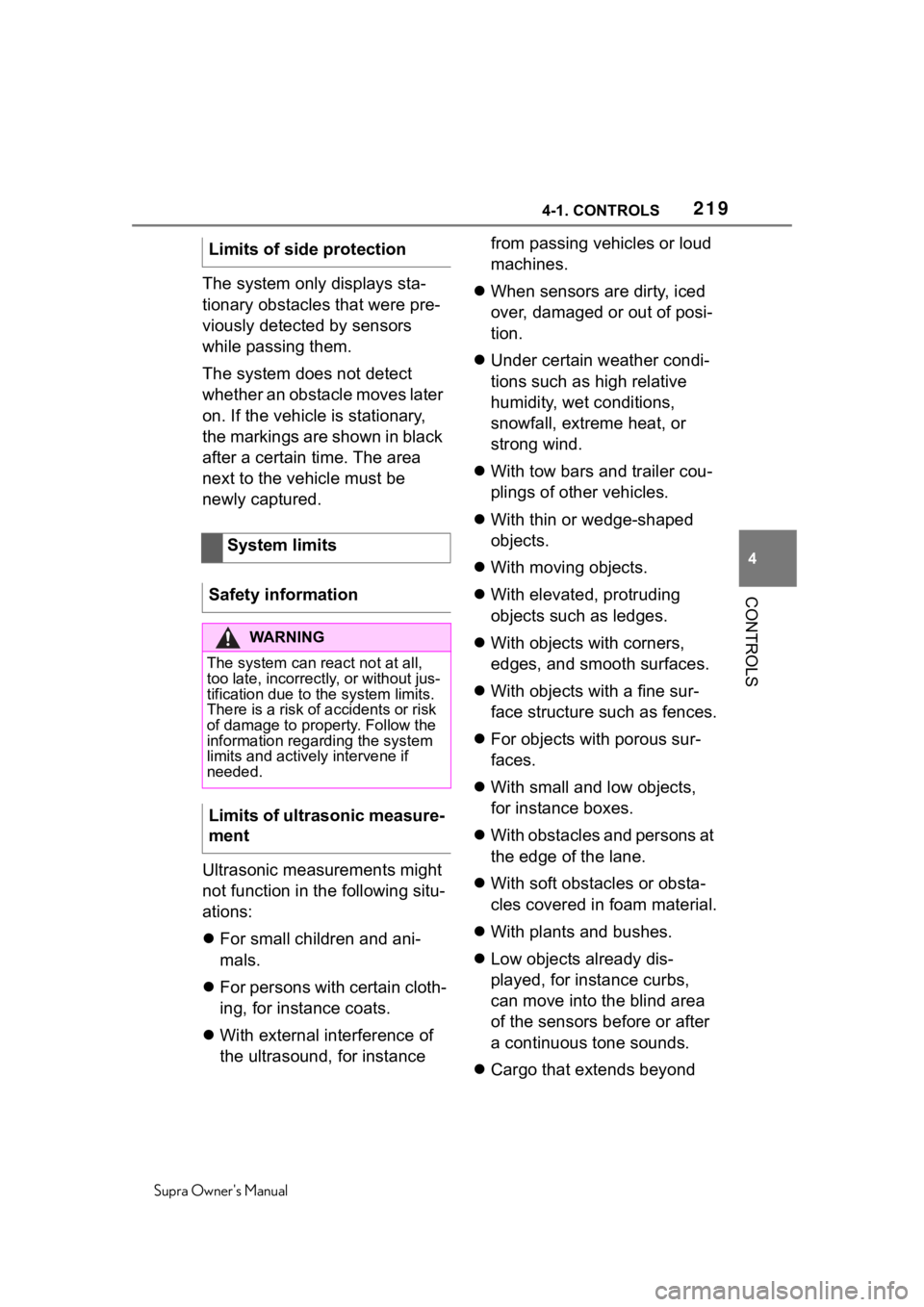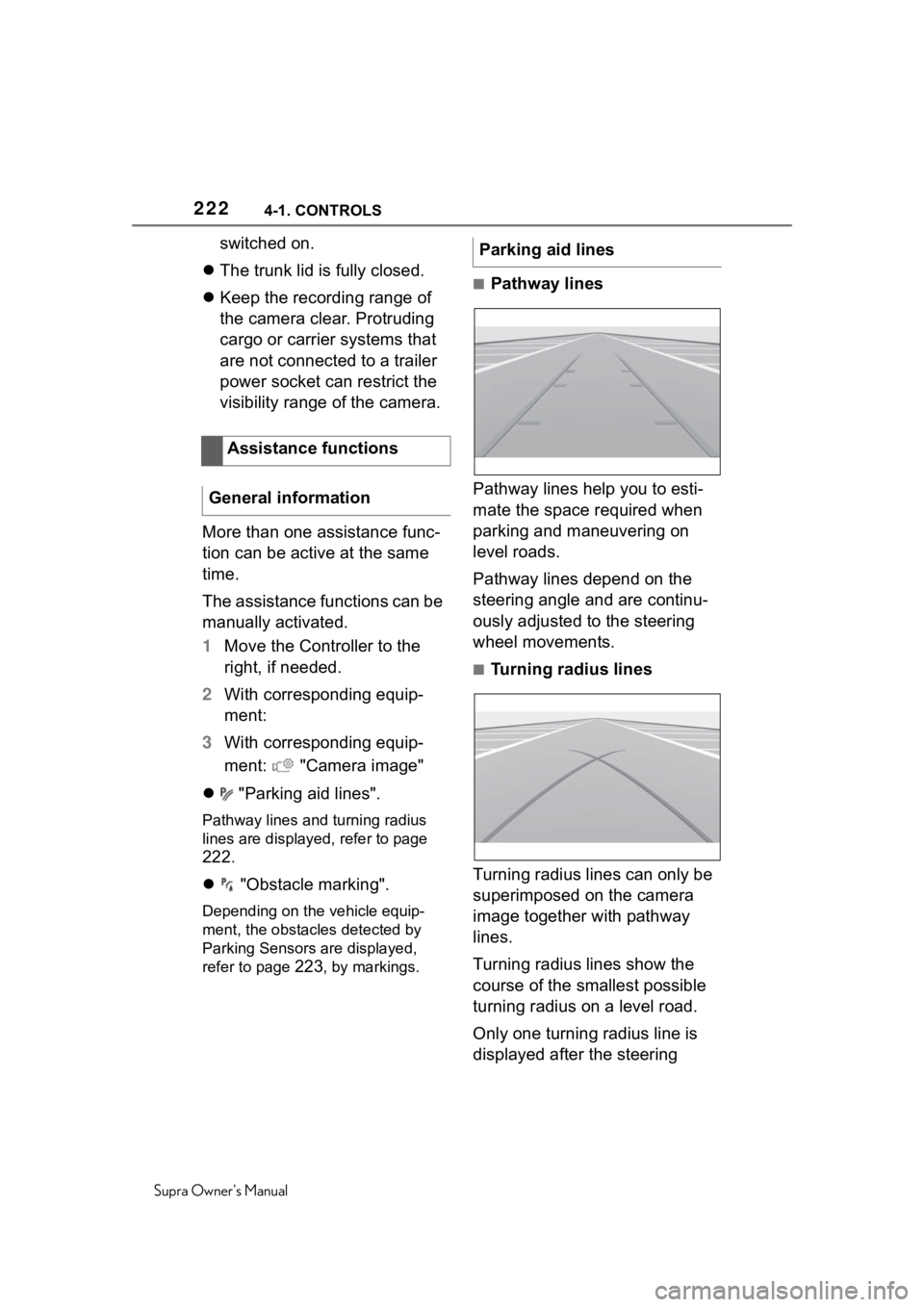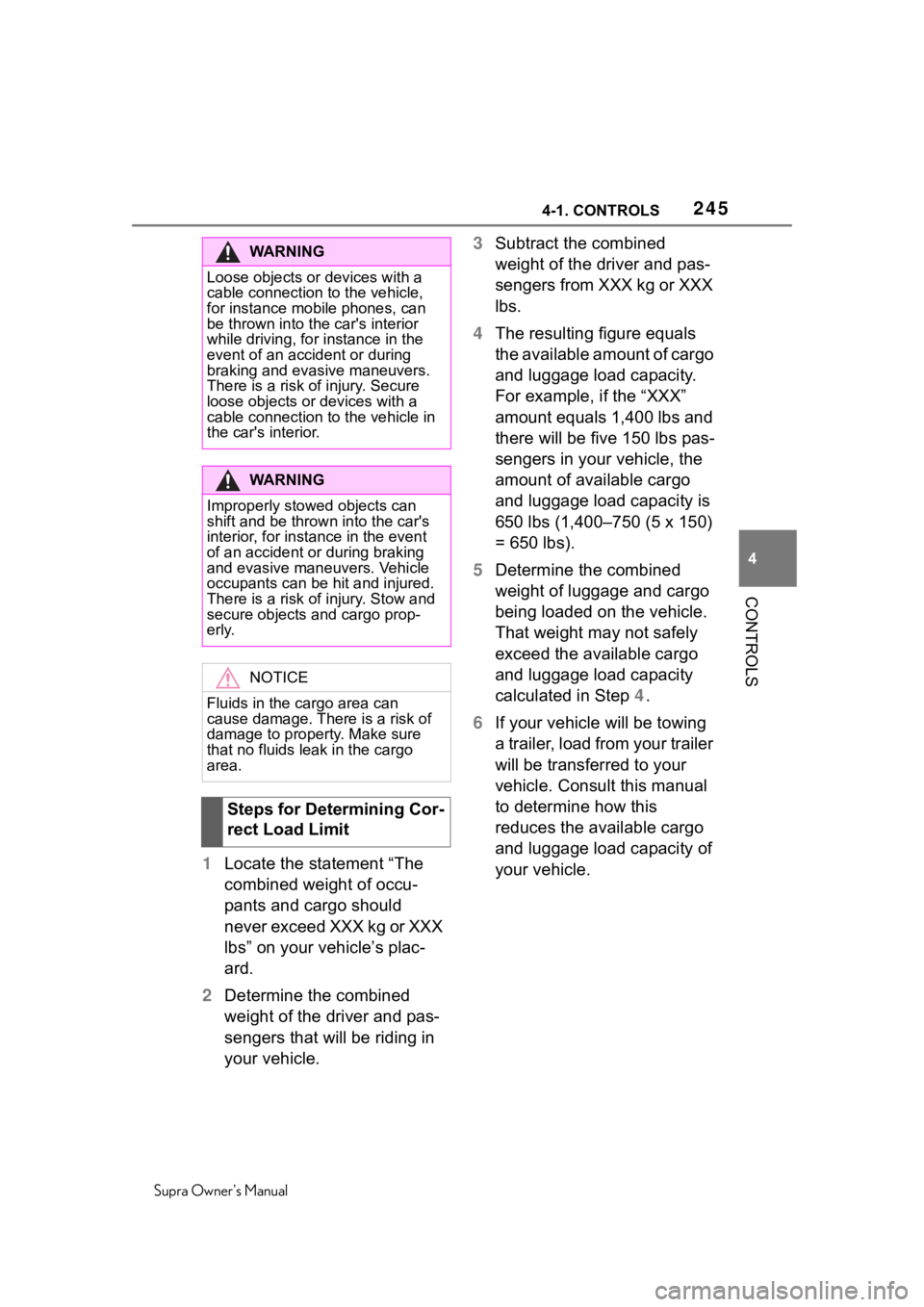trailer TOYOTA SUPRA 2020 Owners Manual (in English)
[x] Cancel search | Manufacturer: TOYOTA, Model Year: 2020, Model line: SUPRA, Model: TOYOTA SUPRA 2020Pages: 356, PDF Size: 6.04 MB
Page 94 of 356

944-1. CONTROLS
Supra Owner's Manual
tored.
The alarm system responds in
situations such as attempts to
steal a wheel or when the vehi-
cle is towed.
The car's interior is monitored to
the height of the seats. The
alarm system is switched on
together with the interior motion
sensor even when the window is
open. Falling objects such as
leaves can trigger the alarm
unintentionally.
The tilt alarm sensor and interior
motion sensor can trigger an
alarm, although no unauthorized
action occurred.
Possible situations for an
unwanted alarm:
• In automatic vehicle washes.
• In duplex garages.
• During transport on trains car-rying vehicles, at sea or on a
trailer.
• With animals in the vehicle.
• When the vehicle is locked after start of fueling.
The tilt alarm sensor and the
interior motion sensor can be
switched off in such situations. The indicator light lights up for
approx. 2 seconds and then
continues to flash.
The tilt alarm sensor and interior
motion sensor are switched off
until the vehicle is locked again.
• Unlock the vehicle with the
remote control.
• Unlock the vehicle using the remote control, if needed,
through emergency detection
of the remote control, refer to
page 82.
• With Smart Key System: if you are carrying the remote
control on your person, grasp
the driver side or front pas-
senger side door handle com-
pletely.
Interior motion sensor
Avoiding unintentional
alarms
General informationSwitching off the tilt alarm
sensor and interior motion
sensor
Press the button on the
remote control within 10
seconds as soon as the
vehicle is locked.
Switching off the alarm
Page 219 of 356

2194-1. CONTROLS
Supra Owner's Manual
4
CONTROLS
The system only displays sta-
tionary obstacles that were pre-
viously detected by sensors
while passing them.
The system does not detect
whether an obstacle moves later
on. If the vehicle is stationary,
the markings are shown in black
after a certain time. The area
next to the vehicle must be
newly captured.
Ultrasonic measurements might
not function in the following situ-
ations:
For small children and ani-
mals.
For persons with certain cloth-
ing, for instance coats.
With external interference of
the ultrasound, for instance from passing vehicles or loud
machines.
When sensors are dirty, iced
over, damaged or out of posi-
tion.
Under certain weather condi-
tions such as high relative
humidity, wet conditions,
snowfall, extreme heat, or
strong wind.
With tow bars and trailer cou-
plings of other vehicles.
With thin or wedge-shaped
objects.
With moving objects.
With elevated, protruding
objects such as ledges.
With objects with corners,
edges, and smooth surfaces.
With objects with a fine sur-
face structure such as fences.
For objects with porous sur-
faces.
With small and low objects,
for instance boxes.
With obstacles and persons at
the edge of the lane.
With soft obstacles or obsta-
cles covered in foam material.
With plants and bushes.
Low objects already dis-
played, for instance curbs,
can move into the blind area
of the sensors before or after
a continuous tone sounds.
Cargo that extends beyond
Limits of side protection
System limits
Safety information
WA R N I N G
The system can react not at all,
too late, incorrectly, or without jus-
tification due to the system limits.
There is a risk of accidents or risk
of damage to property. Follow the
information regarding the system
limits and actively intervene if
needed.
Limits of ultrasonic measure-
ment
Page 222 of 356

2224-1. CONTROLS
Supra Owner's Manual
switched on.
The trunk lid is fully closed.
Keep the recording range of
the camera clear. Protruding
cargo or carrier systems that
are not connected to a trailer
power socket can restrict the
visibility range of the camera.
More than one assistance func-
tion can be active at the same
time.
The assistance functions can be
manually activated.
1 Move the Controller to the
right, if needed.
2 With corresponding equip-
ment:
3 With corresponding equip-
ment: "Camera image"
"Parking aid lines".
Pathway lines and turning radius
lines are displayed, refer to page
222.
"Obstacle marking".
Depending on the vehicle equip-
ment, the obstacles detected by
Parking Sensors are displayed,
refer to page
223, by markings.
■Pathway lines
Pathway lines help you to esti-
mate the space required when
parking and maneuvering on
level roads.
Pathway lines depend on the
steering angle and are continu-
ously adjusted to the steering
wheel movements.
■Turning radius lines
Turning radius lines can only be
superimposed on the camera
image together with pathway
lines.
Turning radius lines show the
course of the smallest possible
turning radius on a level road.
Only one turning radius line is
displayed after the steering
Assistance functions
General information
Parking aid lines
Page 245 of 356

2454-1. CONTROLS
Supra Owner's Manual
4
CONTROLS
1 Locate the statement “The
combined weight of occu-
pants and cargo should
never exceed XXX kg or XXX
lbs” on your vehicle’s plac-
ard.
2 Determine the combined
weight of the driver and pas-
sengers that will be riding in
your vehicle. 3
Subtract the combined
weight of the driver and pas-
sengers from XXX kg or XXX
lbs.
4 The resulting figure equals
the available amount of cargo
and luggage load capacity.
For example, if the “XXX”
amount equals 1,400 lbs and
there will be five 150 lbs pas-
sengers in your vehicle, the
amount of available cargo
and luggage load capacity is
650 lbs (1,400–750 (5 x 150)
= 650 lbs).
5 Determine the combined
weight of luggage and cargo
being loaded on the vehicle.
That weight may not safely
exceed the available cargo
and luggage load capacity
calculated in Step 4.
6 If your vehicle will be towing
a trailer, load from your trailer
will be transferred to your
vehicle. Consult this manual
to determine how this
reduces the available cargo
and luggage load capacity of
your vehicle.
WA R N I N G
Loose objects or devices with a
cable connection to the vehicle,
for instance mobile phones, can
be thrown into the car's interior
while driving, for instance in the
event of an accident or during
braking and evasive maneuvers.
There is a risk of injury. Secure
loose objects or devices with a
cable connection to the vehicle in
the car's interior.
WA R N I N G
Improperly stowed objects can
shift and be thrown into the car's
interior, for instance in the event
of an accident or during braking
and evasive maneuvers. Vehicle
occupants can be hit and injured.
There is a risk of injury. Stow and
secure objects a nd cargo prop-
erly.
NOTICE
Fluids in the cargo area can
cause damage. There is a risk of
damage to propert y. Make sure
that no fluids leak in the cargo
area.
Steps for Determining Cor-
rect Load Limit